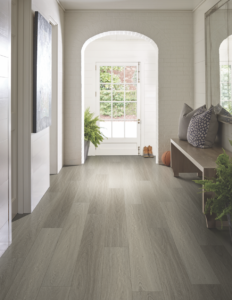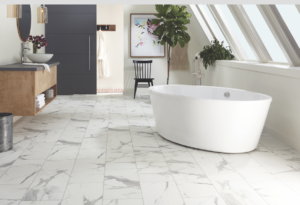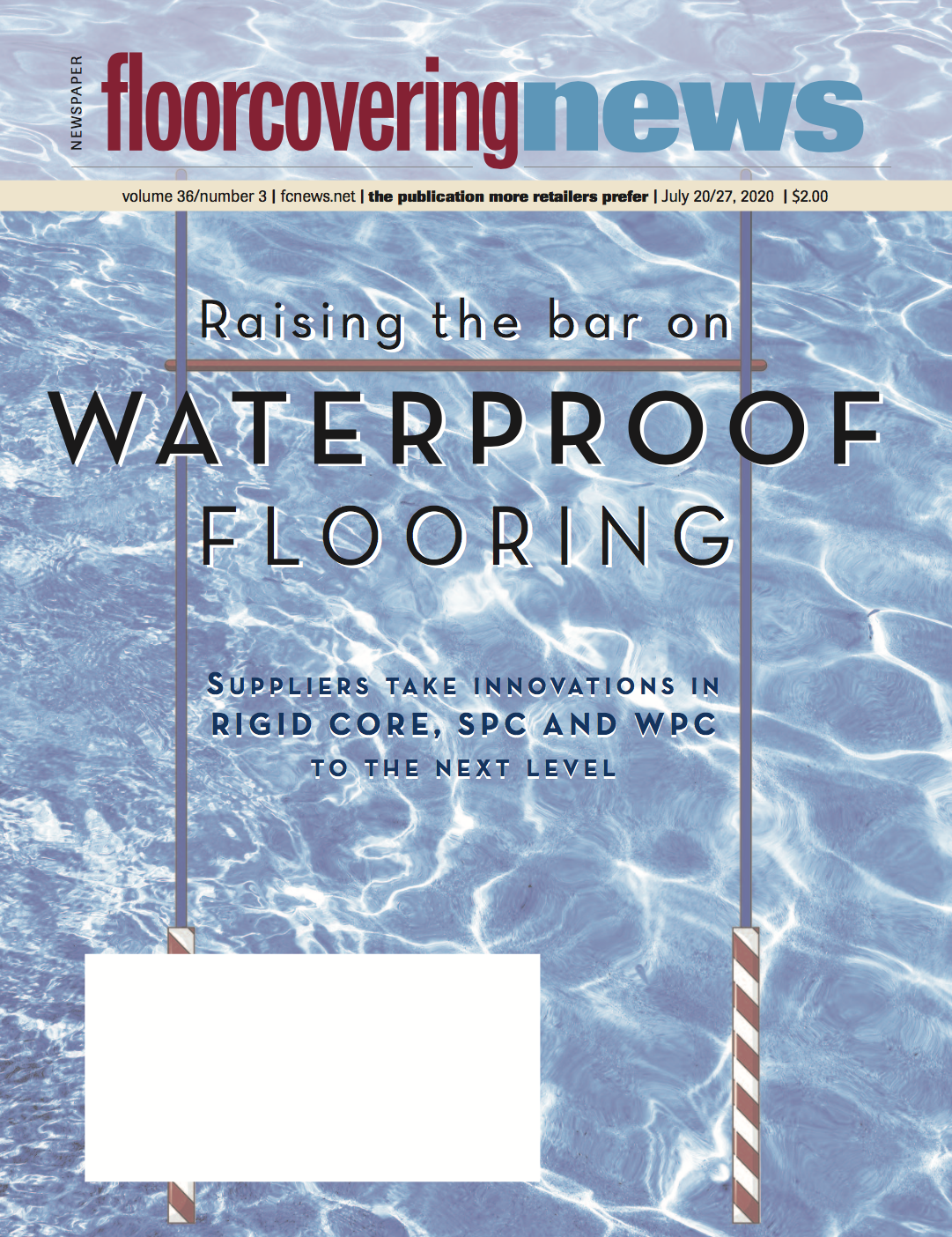By Megan Salzano

The waterproof resilient flooring category continued its meteoric rise in 2019, and nowhere is that more evident than in the SPC subsegment of the LVT category. Not only is the product seizing more market share from competing flooring products, but industry executives also say it’s cannibalizing sales from products within the resilient segment.
“The continued proliferation of SPC in the commercial and residential markets has been the single-largest driver of this continued strong increase in LVT,” said Jeremy Whipple, vice president of commercial business development, Novalis.
FCNews research shows the residential market made up 67% of total resilient revenue or $3.657 billion. With respect to volume, residential resilient accounted for two-thirds of square footage shipped or 3.38 billion square feet. The bulk of that activity was driven by residential LVT (including glue down, flexible click, loose lay, SPC and WPC), which generated an estimated $3.038 billion in revenue. In terms of volume, residential resilient accounted for 1.996 billion square feet.
Resilient manufacturers attribute the category’s success, in part, to the strength of key end-use sectors. “Markets such as multi-family and manufactured housing were seeing growth as economic conditions were very good and the channels were growing at a record pace,” said Kevin Howell, senior director of sales and product management, Beauflor. “The visual and performance aspect of the category has come a long way in comparison to years past—it’s leaps and bounds from where it was even five years ago. It’s really impressive, the past two years, what we’ve seen it do here.”
But it’s not just realistic visuals that’s driving interest; performance is also winning consumers over. “Waterproof floors were a high priority for consumers in 2019,” said Jenne Ross, director of marketing, Karndean Designflooring. “By marketing flooring as ‘waterproof,’ this helped to break the stigma against luxury vinyl tile. In the past, consumers were hesitant of luxury vinyl simply because it had the word ‘vinyl’ in it, because they previously had bad experiences with it.”
Shifting trends

The LVT segment, resilient’s growth heavy hitter, saw some major shifts happen in 2019. From the decline in flexible click to the surge in rigid core and SPC and its cannibalization of the WPC subsegment, LVT was driven by several new factors. “SPC is the fastest growing category due to great aesthetics, waterproof properties, impact resistance, dimensional stability and overall value,” said Ana Torrence, hard surface category manager, Engineered Floors. “These attributes, coupled with the ease of installation, has accelerated growth in this category’s popularity in a time where qualified installers are in short supply.”
Industry observers agree, SPC is primarily taking share from other segments due to its performance attributes. “The big three are dimensional stability, telegraphing and temperature,” said Jeff Francis, resilient category director, residential division, Shaw Industries. “And it just continues to perform. We don’t think SPC is done—we’re still in the growth cycle before we hit the life cycle and start peaking. I don’t see that changing until another major innovation comes along.”
FCNews research shows that in one year the subsegment doubled in terms of volume and more than doubled in terms of dollars. According to the research, the subsegment accounted for 37.1% of the LVT market in terms of residential dollars or $1.126 billion, com- pared to $490 million in 2018. In terms of residential volume, SPC accounted 33.4% of the LVT market or 667.5 million square feet, compared to 335.5 million square feet in 2018.
SPC’s run on its WPC counterpart is evident in the numbers. FCNews research shows WPC declined 17.4% in terms of dollars to $929 million in 2019, compared to $1.125 billion in 2018. In terms of volume, WPC declined 16% to 429 million square feet in 2019, compared to 511 million square feet in 2018.
“Little to no [resilient] investment is in growing incremental WPC capacity,” said Ed Sanchez, vice president product management, Mohawk Industries. “Globally, I think you’ll see people looking at shifting their manufacturing from WPC to SPC. Very few new SKU intros done in the space have been in WPC. That is the trend that will continue until we see the next innovation.”
When comparing WPC vs. SPC, Kurt Denman, chief marketing officer, Congoleum, said, “You trade almost no performance attributes from WPC to SPC, but you get it at a much better price point. So, we think it’s still going to continue to be the growing category, and it’s going to move all WPC to SPC.”
Mohawk’s Sanchez explained that the performance characteristics of WPC vs. SPC came into view for many consumers who began the five-to-six-year moving cycle in 2019. “They are seeing that WPC, though it was beautiful, didn’t have the same durability that the new SPC does,” he explained. “So, you’re seeing a lot of data come back from consumers who— after moving fridges and heavy couches—are seeing dents. That’s creating an increased awareness, and SPC gives you all of the benefits [of WPC] plus solves some of these issues.”

